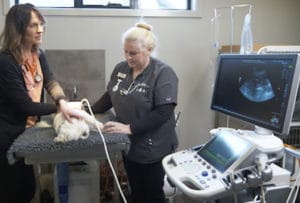
As pets continue to be perceived as members of the family, an increasing number of people are wanting to prepare their pets’ meals, including a raw food diet, themselves so they have full visibility over the quality of the ingredients that make up their diet.
The term ‘complete and balanced’ is also becoming increasingly common when describing our pets’ diet. This term is important because it draws our attention to the importance of ensuring our pet‘s get the macro and micronutrients they need to thrive.
When it comes to a raw, evolutionary diet, the term ‘complete and balanced ‘means a raw food diet that contains the right ingredients, in the right percentages to ensure our pet‘s are getting enough protein, fat, fibre, vitamins and minerals. In addition to this, a species appropriate raw food diet provides other health benefits for our pet‘s including antioxidants and phytonutrients (healthy plant molecules).
These natural compounds have a plethora of health benefits including:
– Protecting the cells of the body against damage from environmental chemicals and pollutants
– Promoting healthy ageing
– Acting as anti-inflammatories
– Supporting healthy immune system function
– Promoting healthy metabolism and utilisation of nutrients from the diet
– Stimulating the healthy elimination of waste products from the body and assisting in normal detoxification processes
If you’ve looked into it and have decided that you’d like to start preparing a healthy raw food diet for your furry family member yourself, the most critical thing is getting the right ingredients in the right balance to ensure adequate nutrition.
The calcium and phosphorous ratios must be right!
Whilst adequate levels of macro and micronutrients are vital to a healthy diet, some are fundamentally more critical than others. A key example in our pets’ diet is the need for calcium and phosphorus to be in the correct ratio for proper health and development.
Muscle meat is rich in phosphorus and bones are rich in calcium. Too much of either, particularly during a pup’s growth and development, can result in improper skeletal development and problems later in life including hip dysplasia and some arthritic conditions.
A 1:0.7 ratio of calcium to phosphorus ensures proper orthopaedic development and a raw food diet made up of 80% meat (including offal) and 10% bone will result in the correct calcium to phosphorus ratio.
Muscle meat is one of the richest source of complete protein for our pets. Muscle meats provide all of the amino acids our pets need for healthy muscle growth and function. Amino acids are also key to the function of other important biological processes including healthy immune function and the metabolism of foods and environmental agents by the liver.
In an evolutionary diet, muscle meat would be classed as the following:
– Skeletal muscle
– Heart
– Lungs
– Spleen
– Tripe (aka stomach lining)
– Tongue
This should comprise 75% of a raw food diet and, whilst some of these ingredients may have a bit of an ‘ick’ factor to us, it’s these ingredients that can have the most health-promoting effects for our pets. Many “non-traditional” forms of muscle meat can be the healthiest.
The tongue, for example, is the strongest muscle in the body which translates to it being comprised of maximum protein and minimal fat which could be a great inclusion in pets’ diets if they have pancreatic issues or are ageing and inactive and don’t require as much fat in their diet.
The heart is a phenomenal source of nutrition; not only is this organ a source of complete protein, but it’s also the body’s most concentrated form of CoEnzyme Q10. CoEnzyme Q10 is a potent antioxidant which is associated with cardiovascular health. Tripe or stomach lining contains all of the probiotic (good bacteria) benefits dogs would get in the wild from their prey and promotes digestive, immune and general health benefits to our pets.
So blending traditional skeletal muscle meat with some of these less common muscle sources is a great way to approach a DIY raw food diet.
Fat is a vital energy source for our pets. Naturally occurring fats within skeletal muscle and surrounding bone and organs provide a highly digestible natural form of energy. These healthy saturated fats, in appropriate amounts, provide energy for our pets to burn and also contain “fat soluable” nutrients such as vitamins and minerals. Grass fed meat is particularly rich in omega-3 fatty acids, important for brain function.
Pets should also obtain omega-3 fatty acids from fish, at least once per week. Salmon and sardines are both rich in omega-3’s and an easy way to integrate omega-3‘s into your pets’ diet. Just ensure if fresh produce isn’t available, that tinned sources are in spring water with no added salt. It is very important to keep sodium (salt) to minimal levels in our pets’ diets including only what is naturally occurring in nature and not including anything in their diet that has added salt.
Offal is often the prized possession that is first to go when our wolf ancestors would devour their prey and should comprise 5% of a raw diet. Rich in nutrition, not to mention flavour, these are the nutritional powerhouses of an evolutionary diet.
These delicacies include:
– Liver
– Spleen
– Kidneys
– Reproductive organs (ovaries and testes)
– Endocrine organs (thyroid, thymus, adrenal glands)
– Brain
– Eyes
Whilst all of these organs aren’t necessary daily requirements in a home-made DIY raw food diet, there is a critical component and this is the liver. A highly concentrated source of critical fat-solvable vitamins and minerals including A, D, K and E, liver should comprise at least 4% of the of a home-made raw food diet (5% if it is the only organ being used).
As previously mentioned, bone is a crucial ingredient in a raw healthy diet due to its absorbable calcium content. For this reason, bone should comprise 10% of a raw food diet. Not only a rich source of calcium, bone and its often accompanying cartilage, are rich in nutrition due to bone marrow, collagen, glucosamine and chondroitin, all responsible for healthy bone and joint function throughout life. Many of these nutrients also support the immune system.
Plant matter is the final component of a raw healthy homemade diet. A diverse selection of plant matter provides a naturally complete range of vitamins and minerals. Mostly green leafy and coloured vegetables, as well as fruits these supply antioxidants, phytonutrients, fibre and moisture as well as essential vitamins and minerals. Ideally these should be blended / crushed to a pulp to ensure better absorption as pet‘s don’t naturally contain the enzymes necessary to digest plant cell walls and access their nutritional value.
A homemade raw food diet may also include a little top up with other health promoting ingredients that include garlic in small amounts, whole eggs, kelp or spirulina, coconut oil, flax meal, probiotics and prebiotics, ginger, turmeric and any other healthy and superfood ingredients for pets.
It’s important when looking into preparing your own homemade raw food diet for your pets to research the ingredients that are safe and healthy for pets, as ingredients that are healthy for humans aren’t always good for our pets.
A balanced homemade raw food diet would be summarised as follows:
– 70% muscle meat from various sources
– 10% organs including at least 4% liver
– 10% bone with accompanying cartilage
– 10% plant matter and other healthy ingredients
Ingredient selection will change over the course of your pet’s life based on their age and activity. For example, fattier cuts of meat are great for growing puppies and active or working dogs. For less active or older dogs, you would be choosing leaner cuts of meat, lower in fat for your pet.
Varying the types of protein sources and the choice of plant matter is important for maximum nutritional exposure over the course of your pet’s life. Just like us humans, pets need variation in their diet to ensure it is balanced.
When it comes to quality and processing of food, if you have the time, the ingredient availability and the equipment, there is no better option than your own kitchen.
For those of us looking for a more convenient option or, if preparing a balanced homemade raw food diet for your pet seems overwhelming, a commercially made raw food diet like Big Dog is a great alternative.
Ensuring a commercially made raw food diet is comprised of 100% human-grade, Australian ingredients and manufactured in alignment with safe food practices and appropriate industry guidelines is the key to assessing quality.
A food science graduate, Chris Essex founded Big Dog Pet Foods in 2000 after many years working in the smallgoods industry, before he recognised a gap in the market to create pet food for dogs made up of bones and raw food that was full of nutritional ingredients. Visit www.bigdogpetfoods.com

What to feed a dog at each life stage

Poor gut health and dog behaviour issues

Support dog gut health when taking medications

Keeping pets safe at Christmas



Get your paws on Lara Shannon’s best selling books ‘Eat, Play, Love (your dog) and World of Dogs.
Available in Australia, USA, UK and Canada.